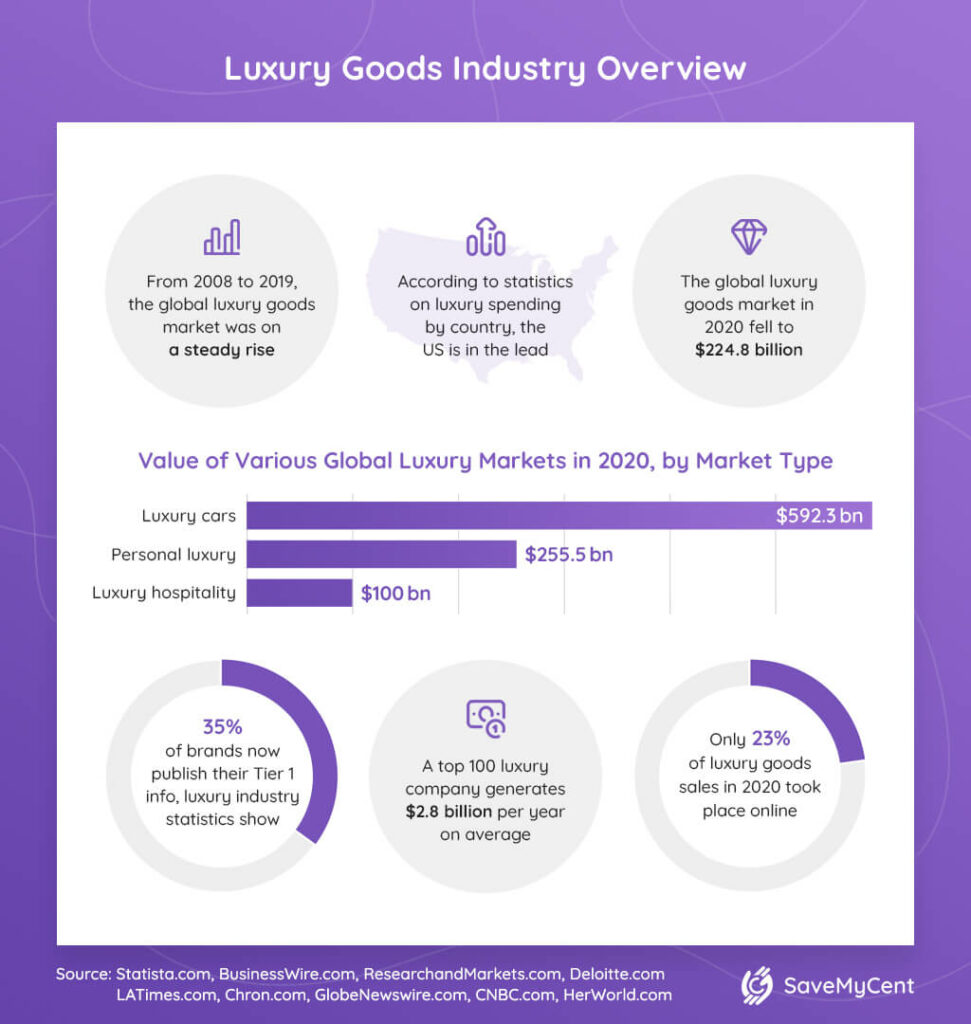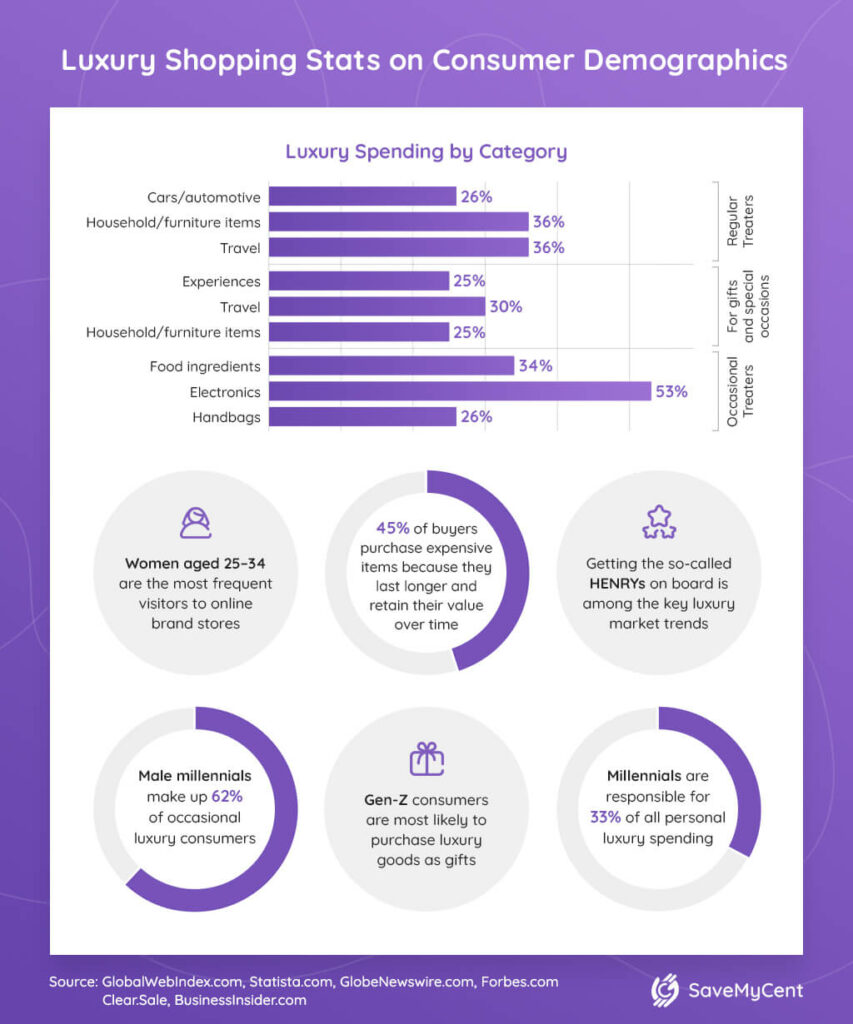For most people, luxury shopping is about occasional splurges on more expensive items. Whether you’re buying a gift or just want to treat yourself, luxury shopping isn’t something you often do.
However, the market of luxury items has been thriving for decades, if not centuries.
The luxury shopping statistics you’re about to read will answer some of the most asked questions about luxury shopping. In this overview, you’ll learn about the recent market trends, shopping habits of the wealthy, and exactly how resilient the luxury industry is.
Top Luxury Shopping Statistics (Editor’s Choice)
- Luxury goods generated $224.8 billion in 2020, down 32% from 2019.
- A top 100 luxury company earns $2.8 billion a year on average.
- Only 23% of luxury goods transactions in 2020 took place online.
- The luxury resale market is expected to reach $68.5 billion by 2026.
- Women aged 25–34 are the most frequent visitors to online luxury stores.
- Millennials are responsible for 33% of all personal luxury purchases.
Luxury Goods Industry Overview

In this section, we’ll closely examine the industry’s current state. You’ll learn the difference between types of luxury brands, find out where the industry is in terms of trends and value, and discover some other interesting facts you might not have known before.
1. There are five types of luxury goods brands.
(Investopedia, Agence Luxury)
The term luxury good describes an item that isn’t a necessity but is highly desirable. In other words, luxury goods are not about fulfilling people’s basic needs — they’re about indulgence. A luxury good can be an item (e.g., a car or a yacht) or a service (e.g., a personal chef).
In general, we can distinguish between five types of luxury retail industry brands:
- Prestige brands — known for their quality and rich history (e.g., Aston Martin)
- Masstige brands — embraced by the masses (e.g., Apple)
- Premium brands — not quite prestige, but still seen as status symbols (e.g., Rolex)
- Boutique brands — unique, artisanal products (e.g., handmade clothing)
- Fashion brands — known for timeless rather than seasonal pieces (e.g., Gucci)
2. From 2008 to 2019, the global luxury goods market was on a steady rise.
(Statista)
The luxury items market has proven to be very resilient to negative trends. Its latest drop in value happened in 2009 due to the global financial crisis. The market quickly recovered and resumed continuous growth, reaching its peak in 2019 when it totaled $330.9 billion.
3. The global luxury goods market in 2020 fell to $224.8 billion.
(Business Wire, Research and Markets)
Many industries saw massive losses in 2020 due to the COVID-19 pandemic, and luxury items were no exception. Originally projected to grow to $349.1 billion, the market instead experienced a severe 32% decline — down to $224.8 billion by the year’s end.
Experts predict the market will resume growth in the coming years, reaching $312.8 billion by 2027. At the projected annual growth rate of 2.7%, the luxury items market would take until at least 2029 to once again reach its pre-pandemic value.
4. According to statistics on luxury spending by country, the US is in the lead.
(Statista)
Americans spent $64.8 billion on luxury items in 2020, putting the US ahead of China ($51.8 billion) and Japan ($21.2 billion). The Americas combined held 28% of the entire global luxury market in 2020, followed by China with 20% and Japan with an 8% share.
5. The COVID-19 pandemic inspired brands to change their luxury ecommerce approach.
(Deloitte, ACI Worldwide)
Due to partial or complete lockdowns worldwide in 2020, most consumers stayed at home, driving the growth of online retail sales. In April, the sales went up by an incredible 209% compared to the same month the previous year.
These developments made luxury brands change their approach to online commerce.
Some brands launched live streams following the “see now, buy now” principle. Dolce & Gabbana’s video boutique proved to be a massive success, which was also true of Prada’s collaboration with Tmall, owned by the Chinese ecommerce giant Alibaba.
6. 35% of brands now publish their Tier 1 info, luxury industry statistics show.
(Los Angeles Times, Deloitte, Chron)
In every manufacturer’s production chain, Tier 1 companies and facilities represent the key suppliers. To increase transparency and prove that all their chief suppliers operate ethically, a growing number of luxury brands now releases the complete list of their Tier 1 partners.
According to the latest data, 35% of brands — including Hermes and Tommy Hilfiger — have so far published their Tier 1 info, which millennial and Gen-Z consumers particularly value.
7. A top 100 luxury company generates $2.8 billion per year on average.
(Deloitte)
Deloitte’s luxury goods industry analysis revealed that the top 100 luxury companies generated a combined total of $281 billion in the fiscal year 2019. This marked a 5.6% increase from $266 billion the year before. The minimum sales revenue threshold for businesses to even make it onto the list was $238 million.
8. Cars are the highest valued luxury items, retail trends analysis reveals.
(Statista, GlobeNewswire)
The luxury cars market’s estimated value in 2020 was $592.3 billion. Personal luxury items ($255.5 billion) ranked second, followed by the luxury hospitality market ($100 billion).
Industry experts predict that the luxury cars market will keep growing, reaching the value of $655 billion by 2027. The rise in purchasing power and new developments in luxury electric car manufacturing will help drive this growth over the next several years.
If you plan to possess a new or used car, manage your budget wisely.
9. Only 23% of luxury goods sales in 2020 took place online.
(CNBC)
The luxury items market is still catching up with the rest of the retail world in digital sales. One of the key reasons is that luxury goods consumers prefer to see the items in-person before buying them. Also, ecommerce is generally better suited for mass-produced items.
Therefore, it’s no surprise that only 23% of all luxury items sales in 2020 took place online.
But online sales have almost doubled since 2019, when they accounted for just 12% of all transactions. Industry experts predict that more and more luxury brands will start selling online. As a result, digital sales could become the leading industry revenue source by 2025.
10. Luxury fashion retail is still the strongest market, and Louis Vuitton is the world’s leading luxury brand.
(Statista)
Despite being in the business for more than 150 years, the iconic brand hasn’t lost any of its appeal. Louis Vuitton reached the value of $51.7 billion in 2020. The legendary company is followed by two other style giants — Chanel ($36.1 billion) and Hermes ($33 billion), proving that fashion is still the most profitable luxury goods branch.
11. Accessories account for 36% of luxury consumption.
(Statista, Her World)
Premium items like watches, jewelry, sunglasses, and purses all fall into the luxury accessories category, which holds the majority of the luxury market. It’s followed by apparel, hard luxury, and beauty categories — all represented fairly evenly at 21%–22%.
12. The luxury resale market is expected to reach $68.5 billion by 2026.
(Deloitte)
Luxury items maintain their value even after they’ve been used, and luxury shopping stats point to a significant rise in the resale market — from $16.2 billion in 2018 to $68.5 billion by the end of 2026. The resale market is particularly exciting to millennials and Gen-Zers who demand sustainability from their brands and pride themselves on ethical consumption.
Luxury Shopping Stats on Consumer Demographics

For most people, luxury goods consumers might be somewhat of an enigma. It’s no surprise, as their buying habits are a bit different from the majority of consumers. In this section, we’ll examine luxury buyers’ shopping habits and characteristics like age and gender.
13. The luxury goods industry recognizes five types of consumers.
(Agility PR Solutions)
Based on their habits and perception of luxury, there are five groups of luxury consumers:
- Strivers — Typically aged 18–34, these customers see luxury goods as evidence of success. They account for 24% of all luxury shoppers.
- Only-the-best consumers — These customers usually have a higher net income and focus on product quality and durability. They make up 23% of luxury consumers.
- Comfort-first consumers — For this group of luxury consumers, buying from most luxury brands gives their life meaning. They account for 19% of all consumers, and 44% of them are older than 65.
- Aesthetes — Predominantly women over the age of 34, these consumers go for luxury because of design and aesthetics. They make up 17% of all luxury shoppers.
- Trendsetters — Multicultural and very likely to be influenced by social media, these customers see luxury items as something that sets them apart from others. They account for 16% of all luxury consumers.
14. Luxury goods market trends show that most occasional shoppers buy themselves electronics.
(Global Web Index)
For gifts and special occasions, most consumers (30%) will purchase a travel-related product (first-class tickets, for example). But as for occasional personal treats, 53% of them will choose electronics — a new smartphone or a smartwatch, premium headphones, etc.
Most consumers see luxury purchases as long-term investments. Namely, 78% expect to get a lasting, high-quality product, and 60% expect excellent customer service.
15. Women aged 25–34 are the most frequent visitors to online brand stores.
(Statista)
According to luxury shopping statistics, female shoppers are more likely to visit online luxury stores than men. Both genders are most represented in the 25–34 age bracket — 10.5% of all visitors are women, and 9.8% are men from this age group. The age group least likely to visit online luxury stores is over-65, with only 7.5% of female and 5.7% of male shoppers.
16. 45% of luxury goods consumers purchase expensive items because they last longer and retain their value over time.
(GlobeNewswire)
A 2020 luxury goods worldwide market study found that 43% of affluent luxury goods consumers see buying these items as a reward for their hard-earned success. The study notes that consumers from some countries like Italy, France, China, and Germany purchase the goods simply because they like to be surrounded by beautiful and exclusive products.
17. Getting the so-called HENRYs on board is among the key luxury market trends.
(ClearSale, Business Insider)
To build a loyal customer base, luxury brands cater to affluent consumers and those who might become rich — the so-called HENRYs (high-earners-not-rich-yet). Typically, these young consumers earn between $100,000 and $250,000 per year.
Industry insiders note that luxury brands must show authenticity, reliability, and willingness to follow sustainability practices to attract these customers. The problem for brands is that, although high earners, the HENRYs are usually millennials with high rent, student debt, etc.
18. Gen-Z consumers are most likely to purchase luxury goods as gifts.
(Global Web Index)
A recent luxury market report shows that around 33% of consumers who purchase luxury items as gifts to someone belong to the 16–24 age group. Older consumers are less likely to buy someone a luxury gift — for example, only 12% of those aged 55–64 would do so.
19. Male millennials make up 62% of occasional luxury consumers.
(Global Web Index)
Even though many believe women are bigger luxury spenders, statistics show that male shoppers take the top spot among millennials. According to recent research, 62% of millennials who occasionally treat themselves to luxury goods are male.
20. Millennials are responsible for 33% of all personal luxury spending.
(Forbes, Business Insider)
Experts predict that millennials’ impact will grow by 2025, when they’ll be responsible for 50% of all market spending. With that in mind, the luxury industry will have to adapt to millennials’ spending habits. Namely, these young people don’t like to flaunt money and are looking to purchase an experience rather than just an item. On top of that, they value sustainability and are particularly concerned for the environment and animal wellbeing.
In Conclusion
The demand for luxury goods isn’t going anywhere.
For centuries now, the market has successfully adapted to suit the needs of those wealthy enough to purchase luxury goods. Even though these shoppers may be a minority, the luxury market’s strength and endurance don’t depend only on revenue. Luxury items are part of a much bigger market that sets the trends for all other goods categories.
As this overview shows, the luxury items market is continuously growing and finding ways to meet the demands of new generations, particularly millennials and Gen-Zers. And despite the massive hit the market took in 2020, experts are optimistic about its future.
FAQ
Which countries spend the most on luxury goods?
The US has consistently taken the top spot among countries worldwide in terms of spending. In 2020, US consumers spent $64.8 billion on luxury items. They were followed by Chinese ($51.8 billion) and Japanese ($21.2 billion) consumers. Overall, 28% of the total worldwide luxury expenditure in 2020 came from the Americas.
It’s also worth noting that some countries are known for certain types of goods. For example, all Swiss luxury companies ranking among the 100 global industry leaders specialize in watches and jewelry. As for Italy, two-thirds of its luxury companies make clothes and shoes.
How much is the luxury goods market worth?
In 2019, the global market reached an all-time high of $330.9 billion. Despite a projected rise to $349.1 billion, the industry suffered significant losses in 2020 due to the COVID-19 pandemic. By the year’s end, the market fell to $224.8 billion, a 32% year-over-year decline.
How big is the luxury goods market?
Although the market experienced a record loss in 2020, experts are optimistic about its future. They believe luxury goods will bounce back relatively quickly, reaching $312.8 billion by the end of 2027. It will take a little longer for the market to return to its pre-2020 levels, though — at an annual growth rate of 2.7%, this is unlikely to happen before 2029.
What is hard luxury and soft luxury?
These are the two main types of luxury items.
Hard luxury refers to expensive items like cars, yachts, jewelry, and watches. These are timeless items whose manufacturers aim for the wealthiest among consumers. They do this successfully, as luxury shopping statistics suggest cars are the highest valued luxury items.
On the other hand, the term soft luxury refers to apparel, especially that made of leather. It also includes designer clothing, fashion accessories including eyeglasses, and other style-related products.
Sources:
- ACI Worldwide
- Agence Luxury
- Agility PR Solutions
- Business Insider
- Business Insider
- Business Wire
- Chron
- ClearSale
- CNBC
- Deloitte
- Forbes
- Global Web Index
- GlobeNewswire
- GlobeNewswire
- Her World
- Investopedia
- Los Angeles Times
- Maximize Market Research
- Research and Markets
- Statista
- Statista
- Statista
- Statista
- Statista
- Statista
- Statista







![How to Get Free Clothes From Shein? [2024 Guide]](https://savemycent.com/wp-content/uploads/2023/09/How-to-Get-Free-Clothes-From-Shein-336x220.png)
